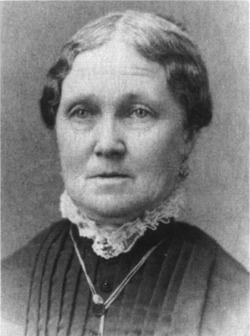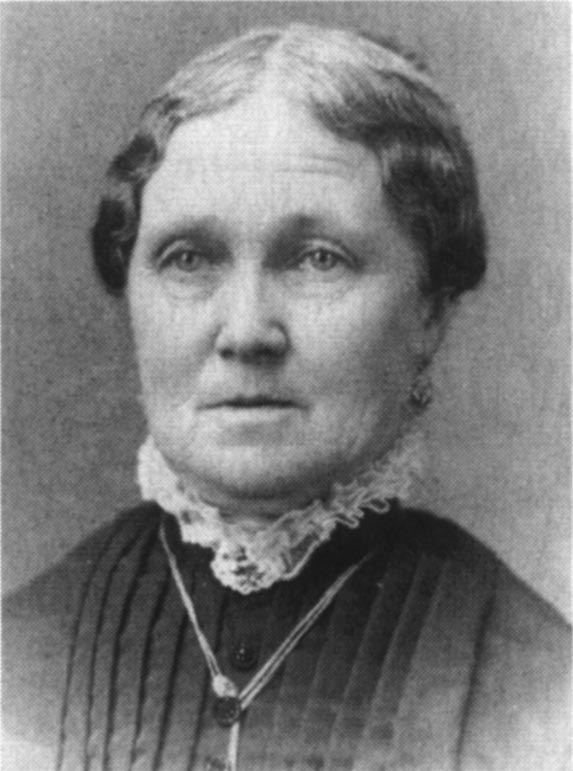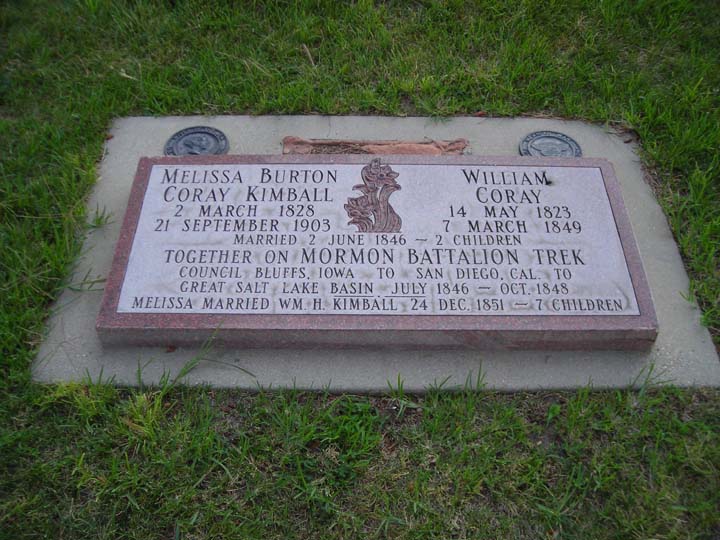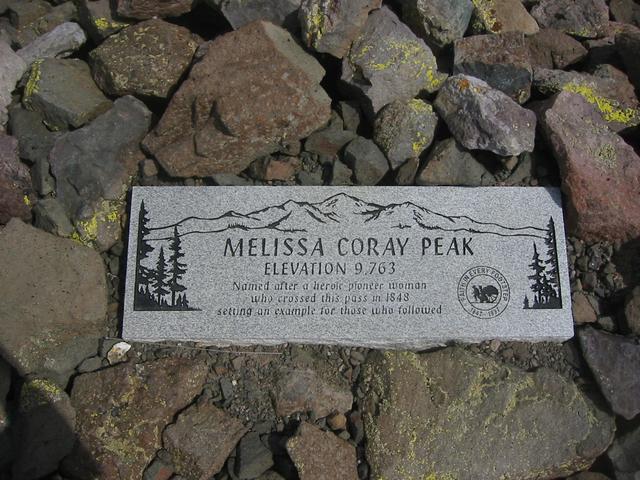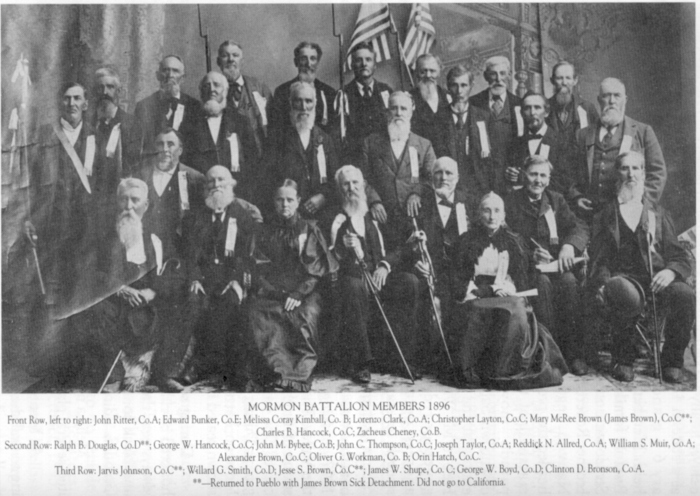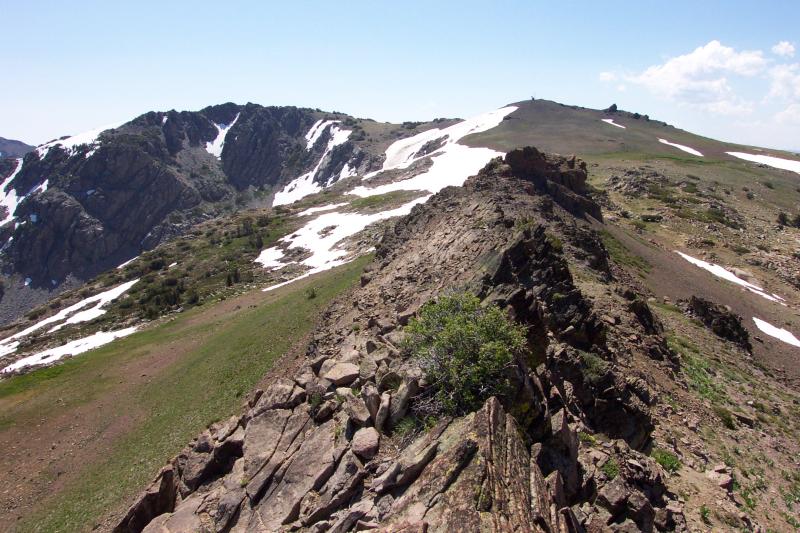Married William Coray, 2 Jun 1846, Nauvoo, Hancock, Illinois
Children - William Coray - born 2 Oct 1847, died within a few months and was buried in Monterey, California; Melissa Coray.
Married William Henry Kimball, 24 Dec 1851, Salt Lake City, Salt Lake, Utah.
Children - Burton Shipley Kimball, Ida Marie Kimball, Ernest Lynn Kimball, Lawrence Prosper Kimball, Robert Taylor Kimball, Charles Martin Kimball, Ranch Stanley Kimball.
History - Melissa Burton Coray Kimball was born in Mersey, Essex, Ontario, Canada to Samuel Burton (1783-1852) and Hannah "Ann" Shipley Burton (1786-1847), both parents were from England.
When Melissa was ten her family was converted to the Church of Jesus Christ of Latter-day Saints, a new church known as The Mormons.
With the rest of her family, she began the march westward, with the body of the Saints. At Mount Pisgah, she became the wife of William Coray on June 2, 1846.
William was the son of Mary Stephens and Silas Coray. Silas Coray was the son of John Coray (1759-1796) and Phebe Howe Coray. Silas's stepfather was James Abbott, father of Stephen Joseph Abbott (1804-1843).
Three months after her marriage the call came for the Mormon Battalion. Melissa knew that her young husband would enlist and made up her mind to go along with him. He was a military man, having served with the Nauvoo Legion. "If he must go, I want to go," she said. "Why must women always stay behind and worry about their husbands, when they could just as well march beside them." Melissa's sister, Rebecca Maria Burton, had married Nathaniel Vary Jones, 14 March 1845. Jones also enlisted and served as a Sergeant in the Mormon Battalion in Company D.
When William told her that there were to be four women with each company employed as cooks and laundresses, she saw a way whereby she might go with him. He was a Sergeant in Company B, and if she were in the same company, it would be entirely safe and proper.
One of the hardest parts of the journey was leaving her father and mother, but as it was a choice between them and her husband, she thought her duty was to her husband. As it turned out Melissa never saw her parents again. Her mother died on June 26, 1847 at Lynn, Atchison, Missouri. and her father died on January 21, 1852 at Suttersville, Sacramento California.
Melissa, like most of the women and soldiers, traveled on foot a large part of the 2,000 miles to San Diego, California, and most of the return journey to Salt Lake. Many times they had very little food and less water, but she and her husband got along very well. Many of the men in the Battalion ate until they were satisfied instead of rationing their allottment. The result was that they consumed their food at the start and did not have any later on when they most needed it. Melissa looked ahead and figured how many days the food would have to last until they met the next supply company, and then she used only so much each day. She tried to cook wisely, so that no food would be wasted.
Although they did not have all they wanted to eat, they were never in danger of starving. She went from campfire to campfire, urging more care in the use of food. She used to relate how, weary and footsore, they had to walk miles and miles without water, and often the men thought they would die. "Thirst only gets worse when you think of it. When I was thirsty, I tried not to think of it." It was at such a time that she learned to carry a pebble in her mouth. This caused the saliva to flow more freely and lessened her unquenchable thirst.
When the Battalion reached Santa Fe, Colonel Patrick St. John Cooke decided to send Captain James Brown of Company C to lead most of the women and children, along with the sick soldiers to Pueblo for the winter. At this, Melissa Coray almost lost courage. But it was not so with her husband. Along with Captain Daniel C. Davis, Captain Jesse D. Hunter and Sergeant Ebenezer Brown, he went to the Colonel to persuade him to let Lydia Hunter, Melissa Coray, Susan Davis, Nancy Brown Davis ("unnamed child of Captain James Brown" mentioned in MB Roster, and wife of Eleazer Davis, Company D) and Phebe Draper Palmer Brown to continue. Just what was said at this conference, the women never knew, but they were permitted to accompany their husbands.
The nausea of early pregnancy made traveling harder for her. Once, after marching two days without water, she saw a number of men crowded around a small spring from which trickled a little stream of water. As it seeped from the rocks they were sucking it through a quill. Small as it was it provided some relief.
William attempted to keep many of the trials of the trip from her, but she knew and shared most of them. One night in Arizona she had a scare that she didn't forget. Mexicans were in the vicinity, and the men were afraid they would be attacked, so they stayed up all night, but nothing happened. About this time, she was becoming extremely weary and footsore, and Col. Cooke seeing her fatigue, got down from his big white horse and offered it to her to ride on.
On January 29, 1847, the Battalion reached San Diego, and Melissa and Sergeant Coray, with others of the Battalion thought their journey ended. After two days there, they were ordered to the Mission San Luis Rey to do garrison duty and protect the place from the Indians. However, in six weeks or so Company B was ordered back to San Diego and Melissa said they camped at Old Town, near the site which is now known as Ramona's Marriage Place. Here she anxiously awaited the time when her husband would be mustered out and could make a home for her and the baby she was expecting.
When the Battalion was discharged in early summer, her husband bought a wagon and some horses, and they started north. At Monterey, a baby boy, William Coray Jr. was born on February 2, 1847, but he only lived a few days and was buried in the little cemetery there.
As soon as she was able to travel, they started out again. She said the trip was hard, the country was new; and there were no roads. They had to pick their way as best they could. In one place they came to a gorge so narrow that they couldn't drive through it. They had to take their wagon apart and carry it through, a piece at a time. When they reached Sutter's Mill near Sacramento, they found that gold had been discovered, and some of the Battalion stopped there. Although the Corays were anxious to get to Salt Lake, they had to remain there long enough to get the means to continue. Mr. Coray sent two sacks of gold back east to bring his mother and sister to Utah.
Melissa and William left for Utah with the Browett-Holmes Company from Pleasant Valley, near present-day Placerville, California. The company consisted of 45 men, one woman (Melissa), two cannons, 17 wagons, 150 mules and horses and about the same number of cattle. They chose the Carson Pass route to avoid crossing the Truckee River numerous times.
It took them six weeks to build a wagon trail over Carson Pass. These were the first wagons to travel this route and the first to go from west to east. For Melissa Coray, this had been the second time she had watched the battalion build a road. The first was the last 700 miles to San Diego. Melissa witnessed a third building of a road, the Salt Lake cut-off just before arriving in the Great Salt Lake Valley from the west.
Melissa wrote the worst night she ever spent was in Nevada. An advance guard of five men had been sent ahead to find the best route and notify the others. But they weren't heard from. Although the rest of the party thought it strange, they kept on. One night, just at dusk, they came upon the bodies of the five men. They had been killed by the Indians with poisoned arrows, and their bodies had been thrown in a gulch and partly covered with underbrush. The bodies were buried, and the small company camped nearby for the night.
They had bought a small cannon before leaving San Diego. They were afraid of an attack that night so the cannon was fired off every little while to scare the Indians. "The firing of the cannon may have kept the Indians away, but it did us more harm than good, for it frightened the horses so that they stampeded, and they had a hard time getting them back, and some were lost.
The returning Battalion members saw their first view of Salt Lake City as they arrived in October, 1848.
Melissa and her husband established their home in the first house built in the old Fifteenth Ward, and it was here that a baby girl was born to them, February 6, 1849. They named her Melissa Coray, born on December 31, 1873. She married Douglas Archibald Swan. In later years, as a widow since 1907, she made her home in Ocean Park and Venice, Los Angeles, California where she died on June 20, 1940.
Grief soon entered the Coray household. Sergeant Coray, weakened by the hardships and exposure of the trip, took seriously ill and passed away on March 7, 1849, less than three months after arriving in Salt Lake City.
Two and a half years later on December 24, 1851, Melissa married William Henry Kimball, eldest son of Heber C. Kimball and Vilate Murray.
Melissa spent the rest of her life in Utah and died in Salt Lake City, September 21, 1903 at the age of 75 years. Her funeral was held on Wednesday, September 23, 1903 in the Fifteenth Ward Chapel. Apostles Orson F. Whitney and Elder Nephi L. Morris spoke. Benediction by J. Golden Kimball. Melissa was buried beside her first husband William Coray in the Salt Lake City Cemetery.
Mormon Battalion, Company B
Married William Coray, 2 Jun 1846, Nauvoo, Hancock, Illinois
Children - William Coray - born 2 Oct 1847, died within a few months and was buried in Monterey, California; Melissa Coray.
Married William Henry Kimball, 24 Dec 1851, Salt Lake City, Salt Lake, Utah.
Children - Burton Shipley Kimball, Ida Marie Kimball, Ernest Lynn Kimball, Lawrence Prosper Kimball, Robert Taylor Kimball, Charles Martin Kimball, Ranch Stanley Kimball.
History - Melissa Burton Coray Kimball was born in Mersey, Essex, Ontario, Canada to Samuel Burton (1783-1852) and Hannah "Ann" Shipley Burton (1786-1847), both parents were from England.
When Melissa was ten her family was converted to the Church of Jesus Christ of Latter-day Saints, a new church known as The Mormons.
With the rest of her family, she began the march westward, with the body of the Saints. At Mount Pisgah, she became the wife of William Coray on June 2, 1846.
William was the son of Mary Stephens and Silas Coray. Silas Coray was the son of John Coray (1759-1796) and Phebe Howe Coray. Silas's stepfather was James Abbott, father of Stephen Joseph Abbott (1804-1843).
Three months after her marriage the call came for the Mormon Battalion. Melissa knew that her young husband would enlist and made up her mind to go along with him. He was a military man, having served with the Nauvoo Legion. "If he must go, I want to go," she said. "Why must women always stay behind and worry about their husbands, when they could just as well march beside them." Melissa's sister, Rebecca Maria Burton, had married Nathaniel Vary Jones, 14 March 1845. Jones also enlisted and served as a Sergeant in the Mormon Battalion in Company D.
When William told her that there were to be four women with each company employed as cooks and laundresses, she saw a way whereby she might go with him. He was a Sergeant in Company B, and if she were in the same company, it would be entirely safe and proper.
One of the hardest parts of the journey was leaving her father and mother, but as it was a choice between them and her husband, she thought her duty was to her husband. As it turned out Melissa never saw her parents again. Her mother died on June 26, 1847 at Lynn, Atchison, Missouri. and her father died on January 21, 1852 at Suttersville, Sacramento California.
Melissa, like most of the women and soldiers, traveled on foot a large part of the 2,000 miles to San Diego, California, and most of the return journey to Salt Lake. Many times they had very little food and less water, but she and her husband got along very well. Many of the men in the Battalion ate until they were satisfied instead of rationing their allottment. The result was that they consumed their food at the start and did not have any later on when they most needed it. Melissa looked ahead and figured how many days the food would have to last until they met the next supply company, and then she used only so much each day. She tried to cook wisely, so that no food would be wasted.
Although they did not have all they wanted to eat, they were never in danger of starving. She went from campfire to campfire, urging more care in the use of food. She used to relate how, weary and footsore, they had to walk miles and miles without water, and often the men thought they would die. "Thirst only gets worse when you think of it. When I was thirsty, I tried not to think of it." It was at such a time that she learned to carry a pebble in her mouth. This caused the saliva to flow more freely and lessened her unquenchable thirst.
When the Battalion reached Santa Fe, Colonel Patrick St. John Cooke decided to send Captain James Brown of Company C to lead most of the women and children, along with the sick soldiers to Pueblo for the winter. At this, Melissa Coray almost lost courage. But it was not so with her husband. Along with Captain Daniel C. Davis, Captain Jesse D. Hunter and Sergeant Ebenezer Brown, he went to the Colonel to persuade him to let Lydia Hunter, Melissa Coray, Susan Davis, Nancy Brown Davis ("unnamed child of Captain James Brown" mentioned in MB Roster, and wife of Eleazer Davis, Company D) and Phebe Draper Palmer Brown to continue. Just what was said at this conference, the women never knew, but they were permitted to accompany their husbands.
The nausea of early pregnancy made traveling harder for her. Once, after marching two days without water, she saw a number of men crowded around a small spring from which trickled a little stream of water. As it seeped from the rocks they were sucking it through a quill. Small as it was it provided some relief.
William attempted to keep many of the trials of the trip from her, but she knew and shared most of them. One night in Arizona she had a scare that she didn't forget. Mexicans were in the vicinity, and the men were afraid they would be attacked, so they stayed up all night, but nothing happened. About this time, she was becoming extremely weary and footsore, and Col. Cooke seeing her fatigue, got down from his big white horse and offered it to her to ride on.
On January 29, 1847, the Battalion reached San Diego, and Melissa and Sergeant Coray, with others of the Battalion thought their journey ended. After two days there, they were ordered to the Mission San Luis Rey to do garrison duty and protect the place from the Indians. However, in six weeks or so Company B was ordered back to San Diego and Melissa said they camped at Old Town, near the site which is now known as Ramona's Marriage Place. Here she anxiously awaited the time when her husband would be mustered out and could make a home for her and the baby she was expecting.
When the Battalion was discharged in early summer, her husband bought a wagon and some horses, and they started north. At Monterey, a baby boy, William Coray Jr. was born on February 2, 1847, but he only lived a few days and was buried in the little cemetery there.
As soon as she was able to travel, they started out again. She said the trip was hard, the country was new; and there were no roads. They had to pick their way as best they could. In one place they came to a gorge so narrow that they couldn't drive through it. They had to take their wagon apart and carry it through, a piece at a time. When they reached Sutter's Mill near Sacramento, they found that gold had been discovered, and some of the Battalion stopped there. Although the Corays were anxious to get to Salt Lake, they had to remain there long enough to get the means to continue. Mr. Coray sent two sacks of gold back east to bring his mother and sister to Utah.
Melissa and William left for Utah with the Browett-Holmes Company from Pleasant Valley, near present-day Placerville, California. The company consisted of 45 men, one woman (Melissa), two cannons, 17 wagons, 150 mules and horses and about the same number of cattle. They chose the Carson Pass route to avoid crossing the Truckee River numerous times.
It took them six weeks to build a wagon trail over Carson Pass. These were the first wagons to travel this route and the first to go from west to east. For Melissa Coray, this had been the second time she had watched the battalion build a road. The first was the last 700 miles to San Diego. Melissa witnessed a third building of a road, the Salt Lake cut-off just before arriving in the Great Salt Lake Valley from the west.
Melissa wrote the worst night she ever spent was in Nevada. An advance guard of five men had been sent ahead to find the best route and notify the others. But they weren't heard from. Although the rest of the party thought it strange, they kept on. One night, just at dusk, they came upon the bodies of the five men. They had been killed by the Indians with poisoned arrows, and their bodies had been thrown in a gulch and partly covered with underbrush. The bodies were buried, and the small company camped nearby for the night.
They had bought a small cannon before leaving San Diego. They were afraid of an attack that night so the cannon was fired off every little while to scare the Indians. "The firing of the cannon may have kept the Indians away, but it did us more harm than good, for it frightened the horses so that they stampeded, and they had a hard time getting them back, and some were lost.
The returning Battalion members saw their first view of Salt Lake City as they arrived in October, 1848.
Melissa and her husband established their home in the first house built in the old Fifteenth Ward, and it was here that a baby girl was born to them, February 6, 1849. They named her Melissa Coray, born on December 31, 1873. She married Douglas Archibald Swan. In later years, as a widow since 1907, she made her home in Ocean Park and Venice, Los Angeles, California where she died on June 20, 1940.
Grief soon entered the Coray household. Sergeant Coray, weakened by the hardships and exposure of the trip, took seriously ill and passed away on March 7, 1849, less than three months after arriving in Salt Lake City.
Two and a half years later on December 24, 1851, Melissa married William Henry Kimball, eldest son of Heber C. Kimball and Vilate Murray.
Melissa spent the rest of her life in Utah and died in Salt Lake City, September 21, 1903 at the age of 75 years. Her funeral was held on Wednesday, September 23, 1903 in the Fifteenth Ward Chapel. Apostles Orson F. Whitney and Elder Nephi L. Morris spoke. Benediction by J. Golden Kimball. Melissa was buried beside her first husband William Coray in the Salt Lake City Cemetery.
Mormon Battalion, Company B
Family Members
-
Mary Burton
1804–1811
-
![]()
Jane Burton Leybourn
1806–1881
-
Samuel Burton
1807–1809
-
![]()
William Burton
1809–1851
-
Samuel Burton
1813–1814
-
![]()
Ann Burton Shipley
1815–1893
-
![]()
Mary Hannah Burton White
1818–1894
-
John Shipley Burton
1820–1820
-
![]()
Gen Robert Taylor Burton
1821–1907
-
![]()
Rebecca Maria Burton Jones
1826–1888
-
![]()
Charles Edward Burton
1830–1896
Sponsored by Ancestry
Advertisement
Advertisement
